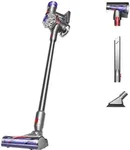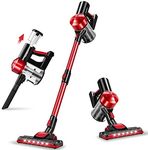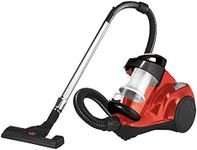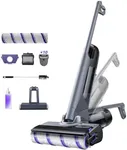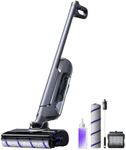Buying Guide for the Best Vacuum For Laminate Floors
Choosing a vacuum for laminate floors is all about finding a model that cleans effectively without damaging the delicate surface. Laminate floors can scratch or lose their finish if the wrong vacuum is used, so it's important to focus on features that offer gentle yet thorough cleaning. Think about your cleaning habits, the size of your space, and whether you have pets or allergies, as these factors will help you decide which features matter most for your needs.Suction PowerSuction power refers to how strongly the vacuum can pull in dirt and debris. For laminate floors, you want enough suction to pick up dust and crumbs, but not so much that it risks pulling up the floor’s seams or finish. Vacuums often have adjustable suction settings; lower settings are usually best for laminate to avoid damage. If you have a lot of fine dust or pet hair, a moderate suction level is ideal, while minimal debris can be handled with the lowest setting.
Brush TypeThe brush type is the part of the vacuum that comes into contact with the floor. For laminate, a soft brush or a vacuum with a brushroll that can be turned off is best. Hard or stiff brushes can scratch the surface, so look for vacuums labeled as safe for hard floors or those with rubber or felt strips. If you have a mix of carpets and laminate, choose a vacuum that lets you switch off the brushroll when cleaning laminate.
Weight and ManeuverabilityWeight and maneuverability determine how easy the vacuum is to move around, especially in tight spaces or under furniture. Lightweight vacuums are easier to carry and less likely to cause fatigue, which is helpful if you have a large area to clean. If you have stairs or lots of furniture, a vacuum with swivel steering or a slim design will make cleaning more comfortable and efficient.
Filtration SystemThe filtration system captures dust and allergens as you vacuum. HEPA filters are the gold standard for trapping tiny particles, which is important if you have allergies or pets. If you’re sensitive to dust, look for vacuums with sealed filtration systems. For general cleaning, a standard filter may be enough, but for allergy sufferers, a HEPA filter is a better choice.
Floor Protection FeaturesFloor protection features include rubber wheels, soft bumpers, and adjustable height settings. These prevent scratches and scuffs on your laminate floors. If you’re concerned about preserving the look of your floors, prioritize vacuums with these protective elements. If your home is high-traffic or you move furniture often, these features become even more important.
Noise LevelNoise level is how loud the vacuum is during use. Some vacuums are designed to operate quietly, which is helpful if you have young children, pets, or prefer a quieter environment. If noise is a concern, look for models that advertise low decibel ratings. For most users, a standard noise level is acceptable, but if you clean early in the morning or late at night, a quieter vacuum may be preferable.
Corded vs. CordlessCorded vacuums plug into the wall and offer unlimited run time, while cordless models run on batteries and offer more freedom of movement. If you have a large area to clean or don’t want to worry about battery life, a corded vacuum is a good choice. If you prefer convenience and portability, especially for quick cleanups, a cordless vacuum may suit you better. Consider your cleaning routine and space size when deciding between the two.
